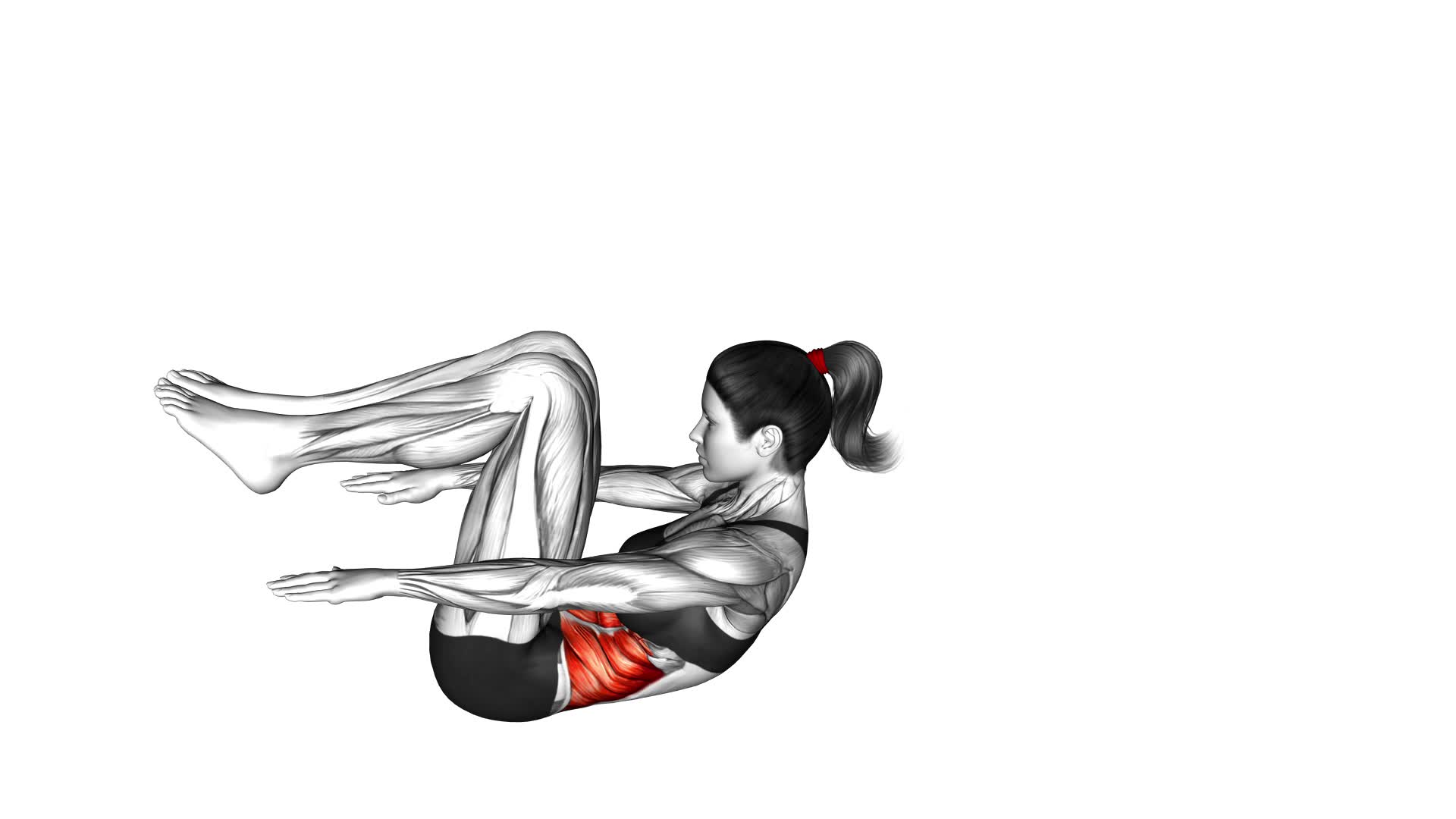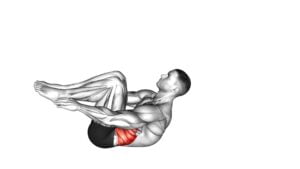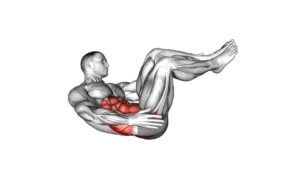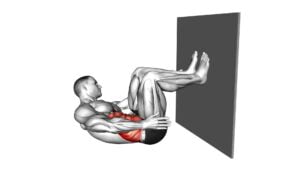90 Degree Heel Touch (female) – Video Exercise Guide & Tips

Are you looking to tone your abs and strengthen your core? Look no further than the 90 Degree Heel Touch exercise!
Watch This Exercise Video
In this video exercise guide, we'll show you how to properly perform this exercise and provide helpful tips for maximizing your results.
Whether you're a beginner or have limitations, we've got modifications to suit your fitness level.
Say goodbye to common mistakes and hello to a more sculpted midsection with the 90 Degree Heel Touch!
Key Takeaways
- The 90 Degree Heel Touch exercise strengthens the abdominal muscles, specifically the rectus abdominis and obliques.
- It improves core stability and overall body coordination.
- The exercise can be modified for beginners by reducing the difficulty level and focusing on engaging the abdominal muscles.
- Advanced practitioners can add variations such as twisting the torso, increasing speed, using an unstable surface, or adding resistance to challenge themselves further.
Benefits of the 90 Degree Heel Touch
To maximize your workout, incorporating the 90 Degree Heel Touch offers numerous benefits. This exercise primarily targets the abdominal muscles, specifically the rectus abdominis and obliques. When performing the 90 Degree Heel Touch, these muscles are engaged as you lift your upper body off the ground and reach your heels with your fingertips. This movement helps to strengthen and tone your core, leading to improved stability and posture.
In addition to targeting the abs, the 90 Degree Heel Touch can be seamlessly incorporated into a full body workout routine. It can be included as part of a circuit or performed in combination with other exercises to create a challenging and effective workout. For example, you can alternate the 90 Degree Heel Touch with exercises like squats, push-ups, and lunges to engage multiple muscle groups and increase overall calorie burn.
Furthermore, the 90 Degree Heel Touch is a versatile exercise that can be modified to suit different fitness levels. Beginners can start by bending their knees and reaching towards their shins, gradually working towards the full 90-degree position. On the other hand, advanced individuals can add resistance by holding a dumbbell or medicine ball while performing the exercise.
Proper Form and Technique for the Exercise
To ensure proper form and technique for the 90 Degree Heel Touch, you should focus on maintaining a strong core and engaging your abdominal muscles throughout the exercise. This will help you stabilize your body and prevent any unnecessary strain on your lower back.
Start by lying flat on your back with your knees bent and feet flat on the ground. Place your arms by your sides, palms facing down. Lift your shoulders off the ground, keeping your neck relaxed and chin slightly tucked.
As you exhale, reach your right hand towards your right heel, while keeping your left hand and left shoulder on the ground. Return to the starting position and repeat on the other side.
It's important to avoid common errors such as using momentum to lift your shoulders off the ground or allowing your lower back to arch excessively. This can lead to ineffective targeting of the abdominal muscles and potential injury.
For those looking for advanced variations, you can add ankle weights to increase resistance or perform the exercise on an unstable surface, such as a stability ball, to further challenge your core stability.
By focusing on proper form and technique, you can maximize the benefits of the 90 Degree Heel Touch while minimizing the risk of injury.
Now, let's move on to the next section to discuss modifications for beginners or those with limitations.
Modifications for Beginners or Those With Limitations
If you're a beginner or have certain limitations, there are modifications you can make to the 90 Degree Heel Touch exercise to accommodate your needs. Here are some beginner modifications and modified exercises that you can try:
- Reduce range of motion: Instead of lifting your legs at a 90-degree angle, you can start by bending your knees to a smaller degree. Gradually increase the range of motion as you become more comfortable and stronger.
- Use a support: If you find it challenging to balance or maintain proper form, you can place your hands on a stable surface, such as a chair or wall, for support. This will help you stabilize your body and focus on engaging the correct muscles.
- Perform the exercise lying down: If standing is too difficult, you can modify the 90 Degree Heel Touch by lying on your back with your knees bent. This reduces the strain on your lower body while still targeting your core muscles.
By incorporating these beginner modifications and modified exercises, you can gradually build strength and improve your fitness level. Remember to listen to your body and only progress to more challenging variations when you feel ready.
Now that you know how to modify the 90 Degree Heel Touch exercise, let's move on to the next section and discuss common mistakes to avoid during the exercise.
Common Mistakes to Avoid During the Exercise
Avoid these common mistakes to ensure proper form and maximize the effectiveness of the Degree Heel Touch exercise.
One common mistake is lifting your head and shoulders off the ground. Remember, the focus should be on your abdominal muscles, not your neck. Keep your head relaxed and resting on the ground throughout the exercise.
Another mistake to avoid is using momentum to lift your legs. This can take away from the targeted effort on your abs. Instead, engage your core muscles to lift your legs, focusing on slow and controlled movements. This will ensure that your abs are doing the work and not other muscles.
Improper foot placement is another mistake that can affect the exercise. Make sure that your feet are positioned hip-width apart and flat on the ground. This will provide stability and help engage your core muscles effectively.
Lastly, avoid rushing through the exercise. Take your time and focus on each repetition. It's better to do fewer reps with proper form than rushing through the exercise and sacrificing technique.
Tips for Maximizing Your Results With the 90 Degree Heel Touch
Looking to maximize your results with the 90 Degree Heel Touch? Here are some tips to help you get the most out of this exercise:
- Maintain proper form: Keep your back straight, core engaged, and shoulders relaxed throughout the movement. This will ensure that you're targeting the correct muscles and avoiding unnecessary strain on your body.
- Focus on control: Rather than rushing through the exercise, focus on slow and controlled movements. This will engage your muscles more effectively and help you build strength and stability.
- Gradually increase difficulty: Once you have mastered the basic 90 Degree Heel Touch, you can challenge yourself by trying variations for advanced practitioners. This could include adding ankle weights, increasing the number of repetitions, or extending the duration of each set.
- Common challenges: Many people struggle with maintaining balance during the exercise. To overcome this, try performing the heel touch while holding on to a stable object, such as a chair or wall. This will help you stabilize your body and focus on the targeted muscles.
- Variations for advanced practitioners: Once you feel comfortable with the basic heel touch, you can try adding a twist to the movement. Instead of simply touching your heel, rotate your torso and reach your opposite hand towards your heel. This will engage your oblique muscles even more and provide a greater challenge.
Frequently Asked Questions
How Many Sets and Repetitions Should I Do for the 90 Degree Heel Touch Exercise?
To get the most out of the 90 degree heel touch exercise, it's important to know the optimal sets and reps.
Without the context of the Degree Heel Touch (female) – Video Exercise Guide & Tips, the ideal number of sets and repetitions would depend on your fitness level and goals.
However, a good starting point would be 3 sets of 10-12 reps.
As you progress, you can increase the number of sets or reps, or even try variations of the exercise to challenge yourself further.
Can the 90 Degree Heel Touch Exercise Help Me Lose Belly Fat?
Yes, the 90 degree heel touch exercise can help you lose belly fat. This exercise targets the oblique muscles and engages the core, which can contribute to overall weight loss.
To get the most out of this exercise, make sure to maintain proper form and engage your abdominal muscles throughout the movement.
Additionally, you can modify the intensity of the exercise by adjusting the speed or adding resistance.
Remember to consult with a fitness professional for personalized guidance based on your fitness level.
Are There Any Specific Muscles That the 90 Degree Heel Touch Exercise Targets?
The 90 degree heel touch exercise targets specific muscles in your body. These include the obliques, rectus abdominis, and hip flexors. By engaging these muscles, you can strengthen and tone your core, which can help to improve overall stability and posture.
It's important to perform this exercise with proper form and control to maximize its effectiveness. Let's dive into the details of how to do the 90 degree heel touch exercise and get the most out of it.
Can I Perform the 90 Degree Heel Touch Exercise if I Have a Lower Back Injury?
If you have a lower back injury, it's important to modify exercises to avoid aggravating your condition.
Performing the 90 degree heel touch exercise may put strain on your lower back, so it's best to avoid it for now.
Instead, focus on exercises that strengthen your core and improve flexibility without putting stress on your back.
Consult with a healthcare professional or a physical therapist to find alternatives that are safe and beneficial for you.
Is It Necessary to Warm up Before Doing the 90 Degree Heel Touch Exercise?
Before performing the 90-degree heel touch exercise, it's highly recommended that you warm up your body. Warming up helps increase blood flow to your muscles, making them more flexible and less prone to injury. It also prepares your body for the intense movements involved in the exercise.
If you don't have time for a full warm-up, you can try alternative exercises like marching in place or doing light leg swings to gradually increase your heart rate and warm up your muscles.
Conclusion
The 90 degree heel touch is a beneficial exercise for strengthening the core and improving overall stability. By maintaining proper form and technique, you can maximize the effectiveness of this exercise.
Beginners and individuals with limitations can modify the exercise to suit their needs. Avoid common mistakes such as lifting the shoulders off the ground or rushing through the movements.
Follow these tips to achieve maximum results with the 90 degree heel touch.

Author
Years ago, the spark of my life’s passion ignited in my mind the moment I stepped into the local gym for the first time. The inaugural bead of perspiration, the initial endeavor, the very first surge of endorphins, and a sense of pride that washed over me post-workout marked the beginning of my deep-seated interest in strength sports, fitness, and sports nutrition. This very curiosity blossomed rapidly into a profound fascination, propelling me to earn a Master’s degree in Physical Education from the Academy of Physical Education in Krakow, followed by a Sports Manager diploma from the Jagiellonian University. My journey of growth led me to gain more specialized qualifications, such as being a certified personal trainer with a focus on sports dietetics, a lifeguard, and an instructor for wellness and corrective gymnastics. Theoretical knowledge paired seamlessly with practical experience, reinforcing my belief that the transformation of individuals under my guidance was also a reflection of my personal growth. This belief holds true even today. Each day, I strive to push the boundaries and explore new realms. These realms gently elevate me to greater heights. The unique combination of passion for my field and the continuous quest for growth fuels my drive to break new ground.







